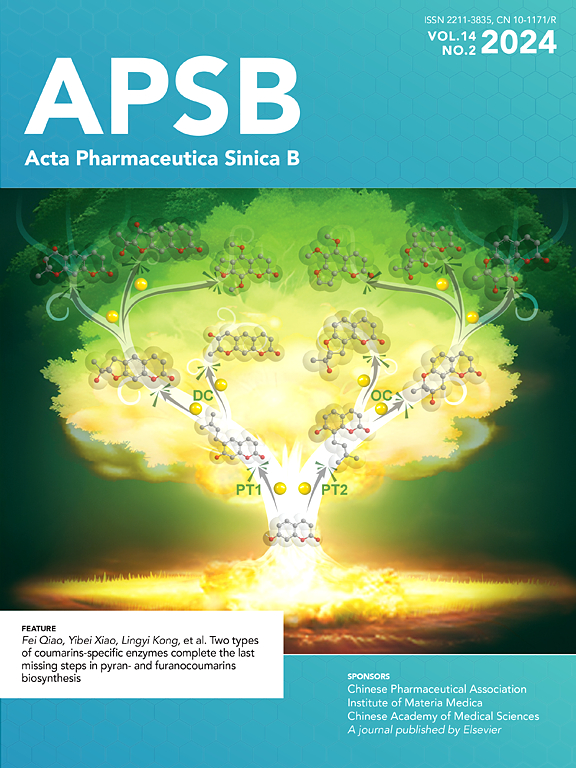GSFM:用于表示药物疗效的基因组尺度功能模块转换,以促进硅学药物发现
IF 14.7
1区 医学
Q1 PHARMACOLOGY & PHARMACY
引用次数: 0
摘要
药物转录组图谱捕捉了药物诱导的基因表达变化,为计算药物发现提供了巨大潜力,并在现代医学中得到广泛应用。然而,目前的计算方法忽视了基因-基因功能网络中的关联,也没有揭示药物疗效与逆转效应之间的系统关系。在此,我们开发了一种新的基因组尺度功能模块(GSFM)转换框架,用于定量评估药物疗效,以促进药物发现。GSFM 采用了四个可从生物学角度解释的量化指标:GSFM_Up、GSFM_Down、GSFM_ssGSEA 和 GSFM_TF,以全面评估每个功能模块(FM)在基因水平、通路水平和转录调控网络水平的多维度活动。通过数据转换策略,GSFM有效地将有噪声和潜在不可靠的基因表达数据转换成更可靠的功能模块活性矩阵,在鲁棒性和准确性方面都明显优于其他方法。此外,我们还发现 RS 与药物疗效之间存在正相关,这表明 RS 可以作为药物疗效的代表性指标。此外,我们还发现 WYE-354、perhexiline 和 NTNCB 分别是治疗乳腺浸润性癌、肺腺癌和阉割抵抗性前列腺癌的候选药物。实验结果验证了所有确定的化合物都具有强大的抗肿瘤作用,为我们的计算方法提供了概念证明。本文章由计算机程序翻译,如有差异,请以英文原文为准。

GSFM: A genome-scale functional module transformation to represent drug efficacy for in silico drug discovery
Pharmacotranscriptomic profiles, which capture drug-induced changes in gene expression, offer vast potential for computational drug discovery and are widely used in modern medicine. However, current computational approaches neglected the associations within gene‒gene functional networks and unrevealed the systematic relationship between drug efficacy and the reversal effect. Here, we developed a new genome-scale functional module (GSFM) transformation framework to quantitatively evaluate drug efficacy for in silico drug discovery. GSFM employs four biologically interpretable quantifiers: GSFM_Up, GSFM_Down, GSFM_ssGSEA, and GSFM_TF to comprehensively evaluate the multi-dimension activities of each functional module (FM) at gene-level, pathway-level, and transcriptional regulatory network-level. Through a data transformation strategy, GSFM effectively converts noisy and potentially unreliable gene expression data into a more dependable FM active matrix, significantly outperforming other methods in terms of both robustness and accuracy. Besides, we found a positive correlation between RSGSFM and drug efficacy, suggesting that RSGSFM could serve as representative measure of drug efficacy. Furthermore, we identified WYE-354, perhexiline, and NTNCB as candidate therapeutic agents for the treatment of breast-invasive carcinoma, lung adenocarcinoma, and castration-resistant prostate cancer, respectively. The results from in vitro and in vivo experiments have validated that all identified compounds exhibit potent anti-tumor effects, providing proof-of-concept for our computational approach.
求助全文
通过发布文献求助,成功后即可免费获取论文全文。
去求助
来源期刊

Acta Pharmaceutica Sinica. B
Pharmacology, Toxicology and Pharmaceutics-General Pharmacology, Toxicology and Pharmaceutics
CiteScore
22.40
自引率
5.50%
发文量
1051
审稿时长
19 weeks
期刊介绍:
The Journal of the Institute of Materia Medica, Chinese Academy of Medical Sciences, and the Chinese Pharmaceutical Association oversees the peer review process for Acta Pharmaceutica Sinica. B (APSB).
Published monthly in English, APSB is dedicated to disseminating significant original research articles, rapid communications, and high-quality reviews that highlight recent advances across various pharmaceutical sciences domains. These encompass pharmacology, pharmaceutics, medicinal chemistry, natural products, pharmacognosy, pharmaceutical analysis, and pharmacokinetics.
A part of the Acta Pharmaceutica Sinica series, established in 1953 and indexed in prominent databases like Chemical Abstracts, Index Medicus, SciFinder Scholar, Biological Abstracts, International Pharmaceutical Abstracts, Cambridge Scientific Abstracts, and Current Bibliography on Science and Technology, APSB is sponsored by the Institute of Materia Medica, Chinese Academy of Medical Sciences, and the Chinese Pharmaceutical Association. Its production and hosting are facilitated by Elsevier B.V. This collaborative effort ensures APSB's commitment to delivering valuable contributions to the pharmaceutical sciences community.
 求助内容:
求助内容: 应助结果提醒方式:
应助结果提醒方式:


